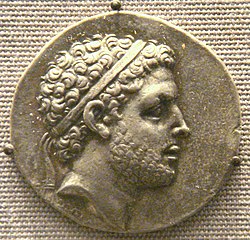
Scopri la mia collezione in 3D
Galleria virtuale
ANCIENT GREECE. AEOLIS, KYME.
Denomination: Silver Tetradrachm, circa 155-143 BC.
Metrophanes, magistrate.
Obverse: head of the Amazon Kyme right, wearing tainia.
Reverse: horse prancing right, one-handled cup below raised left foreleg, KYMAIΩN to right, MHTPOΦANHΣ (Metrophanes) in exergue; all within laurel wreath.
Provenance: ex Kirkhan hoard = ex Auction Hirsch 84, München 1973, Nr. 100.
Reference: This coin illustrated in J. H. Oakley, 'The Autonomous Wreathed Tetradrachms of Kyme, Aeolis', ANS MN 27 (1982) under no. 3 d (this coin!)
Weight: 16,71 g
Diameter: 30 mm
Note: Several Greek cities were named after the Amazons, including Ephesos, Smyrna, Kyme, and Myrina. The Amazons were a fierce tribe of female warriors, renowned for their skills in archery and horseback riding, often in conflict with the Greeks. The obverse of this coin depicts Kyme, an Amazon commander under Queen Myrine. The reverse, showcasing a prancing horse, likely symbolises the Amazons' cavalry training. The wreath surrounding the horse could represent victory and achievement, particularly in horsemanship, celebrating the Amazons' exceptional prowess in both battle and equestrianism. This makes the coin a beautiful tribute to the spirit of the Amazons.
In ancient Greek costume, a tainia (Ancient Greek: ταινία; pl.: ταινίαι or Latin: taenia; pl.: taeniae) was a headband, ribbon, or fillet.

The tainia headband was worn with the traditional ancient Greek costume. The headbands were worn at Greek festivals.[1] The gods also bound their heads with tainiai.[2] Furthermore, cult images,[3] trees,[4] urns, monuments, animal sacrifices and the deceased[5] had tainiai wound around them. They were later adopted by the Romans.[6] A similar type of headband was the diadema, used as a symbol for kings.
Collezione : 17 Greek Tetradrachms and staters
